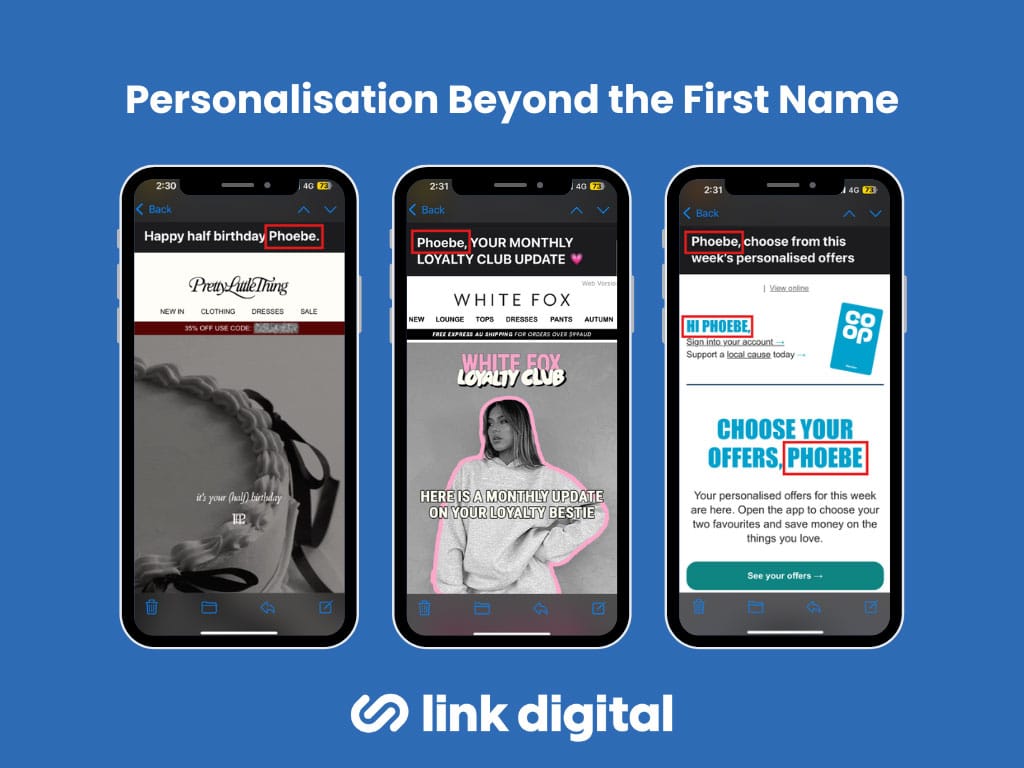
Free Digital Marketing Review
Elevate your online strategy with a personalised report and expert insights. Achieve your business goals faster!
Why Softer Email Marketing Tactics Work Better Than Hard Sales
Email marketing has long been one of the most powerful assets in any brand’s growth strategy, serving as a core component of digital marketing. It’s direct, measurable and personal. But as inboxes have become more crowded and consumers more discerning, the old-fashioned hard sell is losing its edge. Increasingly, it’s the softer, more value driven approach, delivering valuable content, that’s resonating and converting.
As a marketing channel compared to others, email marketing stands out for its ability to foster engagement and build lasting relationships through relevant, targeted communication.
What Do We Mean by ‘Hard Sell’?
The “hard sell” is a direct, often urgent push to get a sale. It’s the “BUY NOW!” subject line, the flashing discounts, the limited time only urgency, and a strong call to action that prompts immediate response. These emails tend to focus on product, price and scarcity, and can work in certain contexts—flash sales or product launches, for instance.
But overuse of this tactic has led to consumer fatigue. People are savvier. They know a marketing ploy when they see one, and they’re more likely than ever to hit delete, or worse, unsubscribe.
Why the Hard Sell Is Losing Its Impact
There are a few key reasons hard selling tactics have started to fall flat in email:
1. Trust is the new currency
Audiences don’t want to feel sold to, they want to feel understood. With rising concerns around privacy, spam and data use, building and maintaining trust has become essential. Personalised communication, where messages are tailored to individual preferences and behaviours, helps foster trust in email marketing by making recipients feel valued and understood. The hard sell can undermine that trust, especially if it feels too pushy or out of step with the recipient’s stage in the buyer journey.
2. Everyone’s doing it
The average person receives around 100-120 emails per day. With so much noise, overly promotional content becomes easy to ignore. In contrast, messages that offer value or relevance stand out. Targeted messages, which are tailored to specific audience segments, are more likely to capture attention in a crowded inbox.
3. Long-term customer relationships matter
Email is not just a channel for gaining quick wins, it’s a long-term relationship builder. Constantly pushing products doesn’t leave much room for nurturing or loyalty building, which is essential for turning subscribers into loyal customers.
What Does a Softer Email Marketing Strategy Look Like?
A softer email strategy moves away from aggressive selling and focuses on helping, informing and engaging your audience. The key elements of this approach include providing value, building trust and maintaining consistent communication. The goal is still to drive action, but the journey is more subtle, with an emphasis on improving email engagement through thoughtful timing, personalisation and responsiveness.
Email marketers are increasingly adopting these softer strategies to improve results.
Here’s what that looks like in action:
1. Educational content over promotional emails
Think helpful guides, how-to’s, case studies or industry trends. This kind of content positions your brand as an expert rather than a salesperson. It builds credibility and keeps your audience opening your emails for the value, not just the offer. Additionally, educational content provides valuable data on what your audience cares about, helping you refine your strategy and improve future campaigns.
Example: Instead of “30% off our SEO packages this week only”, try “5 common SEO mistakes that cost you traffic (and how to fix them)”.
2. Email personalisation
Real personalisation means tailoring content to user behaviour, interests or stage in the sales funnel. Email personalisation goes beyond basic segmentation by leveraging data such as purchase history to deliver highly relevant content. This can include sending personalised emails with content tailored to individual preferences, as well as using personalised subject lines, like including the subscriber’s name, to increase open rates and campaign performance. A well segmented email list allows you to send relevant messages at the right time, making your emails feel more like a service than a sales pitch.

3. Tone that feels human, not corporate
Softer email marketing uses a tone that’s conversational, friendly and real. No jargon, no shouting in all caps—just clear, helpful communication. The goal is to sound like a person, not a robot.
4. Storytelling and brand building
Stories are powerful. Whether it’s a client success story, a behind the scenes look at your team, a note from the director, or inspiration drawn from customer feedback, storytelling adds warmth and relatability to your messages. People connect with people, not faceless brands.
5. Less frequent, more intentional
Quality over quantity matters. You don’t need to send three emails a week if one valuable one does the job. Softer email marketing is about being more intentional by showing up in someone’s inbox when you truly have something worth saying. This approach helps keep subscribers informed and engaged with relevant updates and content.
Why This Approach Works
Softer email marketing may not deliver instant clicks in the same way a 50% off flash sale might, but it leads to more sustainable, profitable results over time, including increased email marketing revenue as a long-term benefit.
- Higher engagement rates: If your audience knows your emails are helpful, they’re more likely to open them consistently. This often results in an improved and higher click through rate, which is a key metrics for evaluating success.
- Lower unsubscribe rates: A softer approach respects your reader’s time and attention, which builds loyalty. Tracking email marketing KPIs is essential to measure campaign performance and ensure ongoing improvement.
- Stronger customer relationships: When your audience trusts you, they’re more likely to buy from you, and become returning customers.
- Increased brand search: Providing valuable email content consistently keeps your brand top of mind, encouraging more people to actively search for your business online.
When Should You Use the Hard Sell?
To be clear, the hard sell isn’t dead. It has its place, particularly in time sensitive campaigns or where your audience already expects a direct offer, especially when a direct response is the goal. Seasonal sales, re-engagement campaigns, cart abandonment emails, or a promotional email, for example, can benefit from a harder edge.
Hard selling tactics still have their place, but they should be used selectively, not as the foundation of every campaign.
What This Means for Your Strategy
Softer email marketing isn’t about being vague or passive. It’s about shifting from pushing products to creating genuine value and connections with your audience. In a crowded inbox, the brands that win are the ones that respect their audience, build trust and show up with relevance and empathy.
So, the next time you’re planning an email campaign, ask yourself: “Would I want to receive this?”. If the answer is no, it might be time to soften your approach.

Need help with your website and marketing?
Book a FREE growth strategy session with our experts
Our award-winning team will review your website and marketing goals to provide you with crucial insight and advice.

4.9 STAR
Google reviews
With 10+ years of experience, Link Digital has helped hundreds of businesses to succeed online. We can help yours too!

